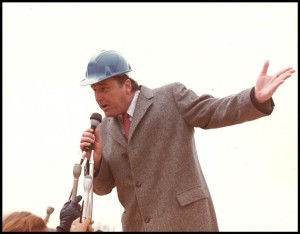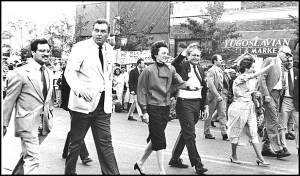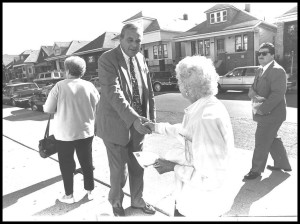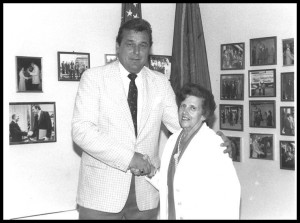Walking tall: Putting Robert Kozaren in perspective. A two-part series
By Greg Kowalski
It was a cold December morning, but the sun was blazing, taking an edge off the biting cold. A small group of men had gathered at the Dodge Main factory, which at this point was one of the biggest architectural wrecks in the world.
Chrysler had recently given up the plant, which, through a complicated financial maneuver was destined to become the site of a new General Motors factory.
Demolition of the massive factory was scheduled to begin in a few weeks, but Mayor Robert “Bob” Kozaren wanted to take a look inside, so he used considerable pull with the state of Michigan, the city of Detroit and GM to get the doors unlocked that bright morning to take a walking tour of the plant.
The group of about five city and state officials wandered through the numerous buildings, taking stock of factory that built modern Hamtramck. Kozaren was as unfamiliar with the plant as anyone there that day, but you could tell he was the man in charge.
Standing about six-foot-seven he was naturally domineering, but he was big in a lot of ways, including with his understanding and affection for the city of Hamtramck.
That shining morning may have been his brightest moment. He was a relative newcomer to the city council when the announcement was made that the Dodge Main plant was being closed by Chrysler.

Kozaren at the ground-breaking for the GM assembly plant, a deal that involved negotiations with GM and Detroit.
This was more than bad news – it was disastrous. Taxes from the Dodge plant supplied one-quarter of Hamtramck’s operating revenue. Without that, the city, already struggling with money woes, faced financial ruin.
Kozaren didn’t bring the GM plant to Hamtramck, but he played a pivotal role in making that happen.
It was perhaps his greatest achievement as mayor. There would be many other accomplishments, and a host of failures as well. They all formed the mosaic of the life of perhaps Hamtramck’s most significant mayor.
Was he the greatest?
Perhaps, but different mayors faced different challenges of their times, so it’s difficult to compare one with another. Al Zak is probably remembered with the greatest affection, but his tenure saw the erosion of Hamtramck’s financial base with little done to stop that.
Kozaren was thrown into a challenging position almost from the first day of his administration in 1980.
Even then, Kozaren was not a newcomer to Hamtramck’s political scene. In fact he was born into it, His father, John Kozaren, served as Wayne County treasurer from 1945 to 1947 and was appointed to the Michigan Liquor Control Commission. He also served on the Hamtramck Building Authority.
A political background
His son Robert was born in 1934 and attended St. Ladislaus High School. With his height, he was a natural for basketball, and he and famed basketball star Rudy Tomjanovich often played on the courts in Hamtramck.
After attending Lawrence Institute of Technology on a basketball scholarship in the 1950s and doing a stint in the army, he served as deputy city clerk during the immense reign of City Clerk Walter Gajewski.
Kozaren’s father had considerable political skills and Gajewski was an absolute master of politics. It was from him that Bob Kozaren learned the artful side of it.
Gajewski knew all the tricks, like positioning yourself at the center of a photo so you couldn’t be cropped out. And when he and Kozaren were at lunch at some prominent place he would have himself loudly paged so others would hear his name.
In another instance, during a particularly close state race, Gajewski deliberately held back turning in Hamtramck’s vote tally to the county until all other communities had filed theirs so it looked like Hamtramck had tipped the race to the winner and thus won his gratitude.
Political gamesmanship, to be sure, but a part of the reality of being a politician.
Kozaren spent 11 years as deputy city clerk then opened Kozaren’s Lounge on Jos. Campau. But being a bar owner was even more challenging than politics. You got to know a lot of people, he once said, but the more they liked you, the more they expected to get free drinks from you. That pushed him back towards politics, and he ran for city council, becoming council president in 1976. He threw himself into the job and wasn’t afraid to get down and dirty – literally – if he needed to.
One afternoon he was spotted on his hands and knees on Jos. Campau picking at a concrete sidewalk. The city had hired a firm to replace bad sidewalks, and Kozaren had questions about the quality of the work.
But it wasn’t sidewalks the moved Kozaren to run for mayor, it was Dodge Main. When Chrysler announced that the plant was closing in May, 1979, Kozaren was alarmed with the city administration’s response – or rather the lack of it.
William Kozerski was mayor, and while he was upset with the situation his attitude was, as he put it, “no one cares about cities with less than 30,000 people,” and he seemed to shrug his shoulders with the attitude that nothing could be done.
Bob Kozaren thought otherwise, which eventually led him to that frosty morning in the big factory.
Up next: Hamtramck’s longest serving mayor faced some of its most difficult problems.




